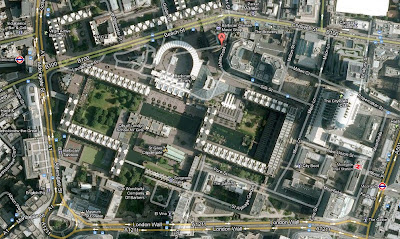Bourtange star fort, restored to 1750 situation, Groningen (province), Netherlands.



Bourtange star fort, restored to 1750 situation, Groningen (province), Netherlands.



Bill Viola (born January 25, 1951) is a contemporary video artist. He is considered a leading figure in the generation of artists whose artistic expression depends upon electronic, sound, and image technology in New Media. His works focus on the ideas behind fundamental human experiences such as birth, death and aspects of consciousness.

Brutalist architecture is a style of architecture, which flourished from the 1950s to the mid 1970s, spawned from the modernist architectural movement.
The Term Brutalism-
The British architects Alison and Peter Smithson coined the term in 1953, from the French béton brut, or "raw concrete", a phrase used by Le Corbusier to describe the poured board-marked concrete with which he constructed many of his post-World War II buildings. The term gained wide currency when the British architectural critic Reyner Banham used it in the title of his 1966 book, The New Brutalism: Ethic or Aesthetic? To characterize a somewhat recently established cluster of architectural approaches, particularly in Europe.
The architectural style known as Brutalism and the architectural and urban theory known as New Brutalism may be regarded as two different movements, although the terms are often used interchangeably. The New Brutalism of the British members of Team 10, Alison and Peter Smithson, is more related to the theoretical reform of the CIAM (in architecture and urbanism) than to "béton brut". Reyner Banham formulated this difference in the title of his book: The New Brutalism - Ethic or Aesthetic?
Chateristics
Brutalist buildings usually are formed with striking repetitive angular geometries, and, where concrete is used, often revealing the texture of the wooden forms used for the in-situ casting. Although concrete is the material most widely associated with Brutalist architecture, not all Brutalist buildings are formed from concrete. Instead, a building may achieve its Brutalist quality through a rough, blocky appearance, and the expression of its structural materials, forms, and (in some cases) services on its exterior. For example, many of Alison and Peter Smithson's private houses are built from brick. Brutalist building materials also include brick, glass, steel, rough-hewn stone, and gabion (also known as trapion). Conversely, not all buildings exhibiting an exposed concrete exterior can be considered Brutalist, and may belong to one of a range of architectural styles including Constructivism, International Style, Expressionism, Postmodernism, and Deconstructivism.
Another common theme in Brutalist designs is the exposure of the building's functions—ranging from their structure and services to their human use—in the exterior of the building. In the Boston City Hall, designed in 1962, the strikingly different and projected portions of the building indicate the special nature of the rooms behind those walls, such as the mayor's office or the city council chambers. From another perspective, the design of the Hunstanton School included placing the facility's water tank, normally a hidden service feature, in a prominent, visible tower.
 Brutalism as an architectural philosophy, rather than a style, was often also associated with a socialist utopian ideology, which tended to be supported by its designers, especially Alison and Peter Smithson, near the height of the style.
Brutalism as an architectural philosophy, rather than a style, was often also associated with a socialist utopian ideology, which tended to be supported by its designers, especially Alison and Peter Smithson, near the height of the style. The best-known early Brutalist architecture is the work of the Swiss architect Le Corbusier, in particular his Unité d'Habitation (1952) and the 1953 Secretariat Building in Chandigarh, India.

Brutalism gained considerable momentum in the United Kingdom during the mid twentieth century, as economically depressed (and World War II-ravaged) communities sought inexpensive construction and design methods for low-cost housing, shopping centres, and government buildings. Nonetheless, many architects chose the Brutalist style even when they had large budgets, as they appreciated the 'honesty', the sculptural qualities, and perhaps, the uncompromising, anti-bourgeois, nature of the style.
Combined with the socially progressive intentions behind Brutalist streets in the sky housings such as Corbusier's Unité, Brutalism was promoted as a positive option for forward-moving, modern urban housing. In practice, however, many of the buildings built in this style lacked many of the community-serving features of Corbusier's vision, and instead, developed into claustrophobic, crime-ridden tenements. Robin Hood Gardens is a particularly notorious example, although the worst of its problems have been overcome in recent years. Some such buildings took decades to develop into positive communities. The rough coolness of concrete lost its appeal under a damp and grey northern sky, and its fortress-like material, touted as vandal-proof, soon proved vulnerable to spray-can graffiti.
*(Information from wikipedia)